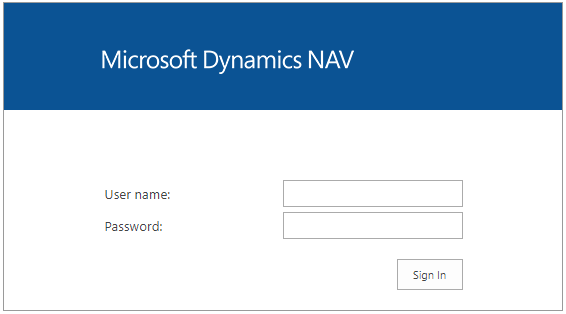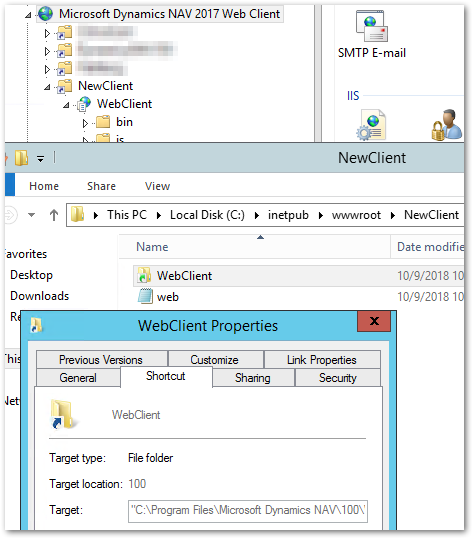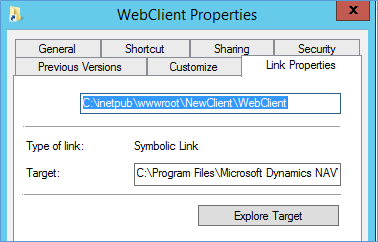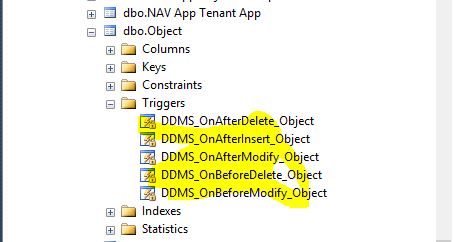Why B2B Businesses Must Evolve Beyond First-Generation E-Commerce
Summary of Cumulative Update For Microsoft Dynamics NAV – October 2018
Cumulative Update for Microsoft Dynamics NAV 2015/2016/2017/2018 Released in Oct 2018
Cumulative Update Summary October 2018
Multiple NAV Builds of Web Clients
Ah, the NAV Web Client of forever unhelpful error messages:

It’s not too hard to get things set up with it correctly once you’ve done it a few times. I ran into an interesting challenge this week, however.
I needed to setup different build versions of the WebClient on the same box. A customer was testing a higher build to move to and wanted the new build of the web client in place to match.
If you’ve never looked under the hood of the WebClient, you get:
- A directory in C:\inetpub\wwwroot
- A virtual directory in IIS to match the above
- The Application in IIS called WebClient under it
- What looks like and acts like a Shortcut in your wwwroot folder to the WebClient installation location
That last one is the troublemaker!
To make a new instance, you use the Powershell command to make the new WebClient instance. For example, I used:
New-NAVWebServerInstance -WebServerInstance NewClient -Server clientservername -ServerInstance newbuildinstance -ClientServicesCredentialType NavUserPassword
This created all the above as discussed:

The problem might be apparent to you already: The Target of that “Shortcut” in Inetpub can’t be changed to a new Target. This points to the WebClient installation, C:\Program Files\Microsoft Dynamics NAV\100\Web Client folder. If I replace that folder’s contents with the new build, that will break my production version of the site. They’re sharing the same application system. But I can’t change the Folder Target.
Enter the Link Shell Extension: http://schinagl.priv.at/nt/hardlinkshellext/hardlinkshellext.html
If you install this Explorer extension, you’ll get the Link Properties tab that I previewed in that screenshot above.
Now when you look at the WebClient shortcut, on that Link Properties tab, you’ll see this is a Symbolic Link, not a shortcut.

The extension lets you change the Target. Now you can make a new Web Client folder elsewhere in the OS, update the files from the new build, and restart that web site. All else functions like any other multi-NAV Web Client installation process.
Creating and Copying Companies in NAV 2018
Dynamics 365 Business Central Apps & Development Environment
How to create Custom APIs for Business Central… even from MacOS!
Your Cumulative Updates for October 2018 are here!
Microsoft publishes October release: Dynamics NAV becomes Dynamics 365 Business Central
Elster Schnittstelle in der Zukunft ohne Übermittlung der Datei
Zukünftig wird die Elster Funktionalität in Microsoft Dynamics NAV und Business Central die Erstellung der XML Datei, nicht jedoch deren Übermittlung unterstützen. Die Änderung hat damit zu tun, dass die bisher genutzte Schnittstelle nicht mehr weiter genutzt werden kann. Wir arbeiten daran, diese Änderung im November Update für alle supporteten Versionen von Microsoft Dynamics NAV und Business Central in der Cloud und On Premises zu veröffentlichen.
Die Originalnachricht finden Sie unten, zusammen mit dem Link zum Yammer Post.
** Important update on the ELSTER/VAT declaration submission feature of NAV & Business Central German version **
Due to changes in technology imposed by ELSTER it will no longer be possible for NAV and Business Central to support automatic submission of the VAT declaration. Instead, customers will have the option to generate and save the declaration XML file locally and manually handle the submission to ELSTER using the ELSTER portal or any other known options.
We aim for this feature to be released on the November update of supported NAV versions and Business Central cloud and on premises.
https://www.yammer.com/dynamicspartnernetwork/#/threads/company?type=general
Mit freundlichem Gruß
Andreas Günther
Escalation Engineer
Microsoft Dynamics NAV
CSS EMEA Dynamics and SMS&P
Dynamics 365 Business Central – jetzt ist es (wirklich) da
#msdny365bc
Wie ihr bestimmt bemerkt habt, wurde vor wenigen Tagen, Anfang Oktober, die neue Version von Dynamics 365 Business Central bereits veröffentlicht. Für viele etwas Früher als erwartet und etwas ruhiger als sonst? Nicht wirklich, da die „Directions US“ diesmal nur wenige Wochen vor der „Directions EMEA“ stattfand, lag es fast auf der Hand. Es sei denn Microsoft hätte die amerikanischen Partner vor den Kopf gestoßen. Dynamics 365 Business Central ist verfügbar.
Da es unterschiedliche Möglichkeiten gibt die Software selbst auszuprobieren, haben wir alle 3 Varianten (Online, Download, Docker) auf unserer Dynamics 365 Business Central / Dynamics NAV Downloadseite aufgelistet.
Dynamics 365 Business Central – was ist wirklich neu
Wer nicht den vollständigen Eintrag lesen möchte, kann sich hier unsere kompakte Audiozusammenfassung anhören.
Alternativ habt ihr die Möglichkeit über diesen Blogeintrag zu lesen. Falls ihr auf der Suche nach mehr Details seid, empfehle ich euch unsere nächste Online-Sendung Dynamics 365 Business Central Whats New – Directions Review am 08.11.18.
Modern | Einheitlich | Intelligent | Anpassbar
Das sind die 4 zentralen Säulen die Microsoft als Zusammenfassung verwendet.
Dynamics 365 Business Central – Modern – Einheitlich
Einige allgemeine Stichworte der UI Optimierungen:
. Headlines
. Intuitive Schaltflächen
. Optimierung der Anordnung von Actions
. Neue Tastaturkürzel
. Optimierte Unterstützung für das Einfügen von Datenätzen
. Filter Optimierungen
. FlowFilter
. Optimierungen der globalen Anwendungssuche
. u.v.m.
Der Webclient wurde in vielen Bereichen optimiert und soll jetzt keine Alternative, sondern die erste Wahl bei der Client-Auswahl sein. Noch existiert der Windows Client der namentlich auch noch immer Dynamics NAV, jetzt mit dem Zusatz „Connected to Business Central“ geführt wird. Die Namensgebung kommt nicht von ungefähr, da die neuesten UI Features ausschließlich in den Webclient integriert wurden. Wer den Windows Client verwendet, bekommt die „Dynamics NAV Benutzer-Erfahrung“. Wir wissen, das bedeutet auch, dass wir mittelfristig (Ankündigung um das Jahr 2020) den Windows Client verabschieden können. Diese Erfahrung mussten aber AX Benutzer bereits viel früher machen und dort funktioniert es offenbar auch. Warum also nicht auch in Business Central wenn der Webclient funktional jetzt endlich soweit ist? Wir werden sehen.
Dynamics 365 Business Central – Intelligent
. Neue zusätzliche Power BI Berichte
. Optimierte und erweiterte „Machine Learning“ Funktionen basierend auf AI
. „Cloud Connector“
. u.v.m.
Allgemein wurde das Thema „Machine Learning“ weiter integriert und optimiert. Gerade in Richtung Vorauszahlungen und der Vorhersage von Zahlungen wurde das Thema AI noch größerer Bestandteil der Anwendung. Somit können bestimmte Vorhersagen mittels Power BI Auswertung noch detaillierter durchgeführt werden. Interessant dabei ist die Möglichkeit Business Central (in der Cloud) als eine Art „Data Warehouse“ zu verwenden um die Daten aus meiner lokalen Datenbank in die Cloud (Read only) zu übernehmen. Damit stehen mir als Kunde dann aber auch die Cloud Services (wie die Powersuite direkt in der Cloud und AI Services) zur Verfügung und können z. B. wiederum mittels Power BI in die Anwendung integriert werden.
Admin Center
. Lizenzverwaltung
. Upgrade Management
. Sandbox Management
. u.v.m.
Gut das war zu erwarten. Microsoft hat für Partner ein sogenanntes Admin Center zur Verfügung gestellt. Darin können Partner ihre Kunden Instanzen verwalten. Schritte wie Upgrades, Testumgebungen, Extensions können dort per Mausklick besser verwaltet werden.
Dynamics 365 Business Central – Anpassbar
Entwicklung – Anpassung
. zahlreiche AL Optimierungen
. optimierte Anpassungsmöglichkeiten
. verbessertes Debugging
. viele neue Events
. u.v.m.
Das aktuelle Release ist vermutlich in den nächsten Monaten einer der letzten die C/AL und AL unterstützt. Da Microsoft bereits in der Lage ist ihre Standardapplikation vollständige auf AL zu konvertieren, wurde gleichzeitig angekündigt das C/AL in den nächsten Versionen eingestellt wird. Zeitraum vermutlich einige Monate.
Für viele klingt dies nun nach etwas Stress und eine schnelle Geschwindigkeit. Natürlich ist das eine Frage der Perspektive und es gibt viele Argumente und Gegenargumente.
Die Fakten sind aber so, wie sie sind. Der Weg muss also weiterhin so rasch als möglich bedeuten sein altes Entwicklungsmodel Objekte zu ändern zu verwerfen und in Richtung Extension zu arbeiten.
Versionen
. alle 6 Monate Minor Release
. keine Major Releases mehr
Wie in den Release Notes angekündigt gibt es ab sofort alle 6 Monate eine sognannte Minor Release. Im Frühling und im Herbst. Die kumulativen Updates dazwischen sollen vorerst wie gewohnt bleiben. Dynamics 3365 Business Central führ in Vertrieb und Marketing daher keine offizielle Versionsnummer oder Jahreszahl mehr.
Der Beitrag Dynamics 365 Business Central – jetzt ist es (wirklich) da erschien zuerst auf Dynamicsblog.
Dynamics 365 Business Central on-premise: enabling in-client personalizations
Dirty Trick to Keep Your Customers Hostage
Overview
Through whatever reasons, the customers will want to work with one partner over another. It may be the lack of knowledge, lack of support, slow response, or whatever. The customer can freely choose who they want to work with in regards to Dynamics 365 Business Central (aka Dynamics NAV).
Of course for the Microsoft NAV partner that the customer is leaving in question, they do not like that. They want to keep the customer on and collect money without doing the work.
It also leads to hurt feelings from the partner in question. I would equate that feeling as being dumped by your significant other.
Nonetheless, one of the best “features” that’s not emphasized enough in the Dynamics 365 Business Central (aka Dynamics NAV) channel is that if the customer does not want to work with a particular company, they can freely choose another one without much problems.
You’re not dealing with Microsoft, you’re dealing with partners that work with Microsoft.
Old Trick to Prevent You from Leaving
There are a couple of dirty tricks that the industry employs to hold the customer hostage.
One of the oldest trick is through licensing. They sell you add-ons that are in the 30 million ranges that only THEIR company have access to.
Often times, the customers will not know they’re in a restricted add-on ranges, because quite frankly, when you’re getting into a new marriage, nothing can go wrong!
I’ve personally met with a few customers that ended up switching to a different ERP software because the previous partner wouldn’t release their code to other NAV partners.
What can you do? Threaten a lawsuit? Or did you read the print when you bought NAV from that company? If you did, did you understand what you were signing?
I fully understand why Microsoft does not want to get involved in these situations. The original selling partner will claim that their add-on is their secret IP and don’t want other people to “steal” it.
On the other hand, if the NAV partner suck or just don’t have the resource available, only the customer will suffer.
This topic should probably warrant a separate blog article since the question of Extensions comes into play. Basically any extensions can be treated like the objects in the 30 million ranges.
Dirty Trick to Prevent You from Leaving
If the customer refuses to purchase the partner’s add-on. The other way is to lock down the database.
How do we know this?
Recently, we worked with a new client that came to us because they didn’t like their previous partner. When we got our first modification request, I was horrified to find that we couldn’t modify any objects in the database.
This is even when I have the sysadmin role on SQL Server!
The error is:
The following SQL Server error or errors occurred when accessing the Object table: 50000,"42000",[Microsoft][SQL Server Native Client 11.0][SQL Server]You do not have permission to modify objects.
SQL:
UPDATE [NAV2016].[dbo].[Object] SET [Compiled]=0,[BLOB Reference]= NULL,[BLOB Size]=924,[Date]={ts '2018-10-11 00:00:00.000'},[Time]={ts '1754-01-01 17:37:53.955'} WHERE ([Type]=1 AND [Company Name]='' AND [ID]=2000000071)Asking Around
Coincidentally, I was at a Dynamics 365 Business Central conference (Directions) where all of the best NAV experts are in one place for me to pick brains from.
When I showed this error around, everyone was stump and had no idea what’s causing this error. I even approach some of the Dynamics NAV MVPs and they asked the usual questions:
1. Are you sysadmin?
2. Do you have administrator on that computer?
No one had seen this error.
The Solution
Finally, Floyd Chan from Qixas Group gave me a hint that if he was devious, he would put code directly in SQL Server tables. More specifically, in the triggers.
Sure enough, checking the Triggers on the Object table in the SQL table, sure enough, we found this:
After removing the table trigger from the Object table, we were freely able to modify the database objects again.
Conclusion
Over the years, I’ve seen a lot of weird and questionable things.
This, to me, left a really bad taste in my mouth. Partners will go as far as locking down the database to prevent other developers on working with them.
I just want to put this out there so people will not have to suffer through this as well. Once is enough.
How to add Cue tiles to existing Cue Page in Business Central using VS Code
Microsoft Dynamics Navision Cumulative Update Summary For October 2018.
Microsoft Have Released Cumulative Update for October 2018.
Please find below the details of Cumulative Updates Released for Microsoft Dynamics NAV 2015, NAV 2016, NAV 2017 & NAV 2018.
Below are the Links to Download the Latest Cumulative Update.
How To: Understand NAV Upgrade Steps Between Cumulative Updates
Business Central – Systemanforderungen
Am 1. Oktober 2018 hat Microsoft die neuste Version von Dynamics NAV veröffentlicht: Microsoft Dynamics 365 Business Central. Zur Vorbereitung auf das Upgrade gibt es hier die Systemanforderungen zum Lesen. Und für die Nostalgiker sind zusätzlich die Systemanforderungen bis zurück zur Version NAV 2009 aufgelistet.
Systemanforderungen für Microsoft Dynamics 365 Business Central On-premises
https://docs.microsoft.com/en-us/dynamics365/business-central/dev-itpro/deployment/system-requirement-business-central
Systemanforderungen für Microsoft Dynamics NAV 2018
https://docs.microsoft.com/en-us/dynamics-nav/system-requirements-for-microsoft-dynamics-nav
Systemanforderungen für Microsoft Dynamics NAV 2017
https://docs.microsoft.com/en-us/dynamics-nav/system-requirements-for-microsoft-dynamics-nav-2017
Systemanforderungen für Microsoft Dynamics NAV 2016
Scheint bei Microsoft verloren zu sein. Der offizielle Link http://go.microsoft.com/fwlink/?LinkId=317819 wird auf NAV 2018 umgeleitet.
Systemanforderungen für Microsoft Dynamics NAV 2015
https://docs.microsoft.com/en-us/previous-versions/dynamicsnav-2015/dd301054(v=nav.80)
Systemanforderungen für Microsoft Dynamics NAV 2013 R2 (PartnerSource-Login erforderlich)
https://mbs2.microsoft.com/fileexchange/?fileID=cd6c7eb9-1dc4-45b8-83e2-4932437a98a6
Systemanforderungen für Microsoft Dynamics NAV 2013 (PartnerSource-Login erforderlich)
https://mbs.microsoft.com/downloads/customer/NAV/2013/SystemRequirementsNAV2013.docx
Systemanforderungen für Microsoft Dynamics NAV 2009 SP1/R2 (PartnerSource-Login erforderlich)
https://mbs.microsoft.com/downloads/customer/nav/general/NAV2009SP1R2_SystemRequirements.doc
Dynamics 365 Business Central/NAV on Azure VMs: tips for best network performances
ISVs in D365FO – The solution to the customization conundrum
Dynamics 365 Finance & Operations provides amazing benefits to those looking to move to a modern, robust and scalable ERP solution without having to devote massive amounts of capital and resources to their IT departments. Running D365FO in the cloud allows companies to focus their resources on their core business functions and the business process reorganization that comes with a major system implementation or upgrade.
It also provides a rock solid enterprise systems infrastructure to all companies, big and small, that house their solution in Azure and manage it with Lifecycle Services. And, while not cheap, it allows companies to spread their systems costs over an extended timeline, freeing up valuable capital for business specific expenses.
That’s all great and a real selling point, but D365FO, like any other ERP, has strengths and weaknesses. ISVs like ours survive on identifying those weaknesses and developing functionality that not only fill the gaps left in the ERP’s capabilities but enhance the overall experience. In our case, it’s parcel and LTL shipping, but there are many others plugging holes and/or expanding on functionality that may not be as complete as desired.
When undertaking a traditional ERP implementation, companies have had to tightly manage the expense of adding additional functionality to an already resource intensive project. As with any cost/benefit or ROI analysis, adding ISV modules can seem daunting from both a time and cost perspective. Frequently, customers would turn to their ERP resellers to write customizations that would resolve the most pressing gaps at reduced time and expense.
Entering the D365FO paradigm shift
Both customers and resellers are discovering Microsoft has altered the traditional ERP implementation paradigm with Azure and Dynamics 365 Finance & Operations. By removing the need for massive capital expenditure and providing enterprise scale systems infrastructure for a subscription fee, they have minimized the significant capital and resource burden of an ERP implementation.
But it comes with a catch. Microsoft releases quarterly updates to D365FO and requires customers be no more than two releases behind at any given time. This all but removes the traditional use of customizations, especially extensive ones. In the past, a company with an extensively customized ERP solution could pick and choose updates or forego them altogether to avoid having to redevelop the customized code in order to conform to the updated ERP. This model is no longer an option in the Azure/D365 world.
AppSource – The App store for Dynamics 365
Part of Microsoft’s strategy for maintaining and updating their Azure/D365 cloud environments is to provide an enterprise level equivalent to the traditional App store. ISVs who wish to resell their solutions to the D365 community need to go through a Microsoft vetting and approval process in order to make their solutions available to D365 customers. Those ISVs are also required to keep their solutions current with the latest release of D365.
This provides D365FO customers with the peace of mind that any ISV solution they purchase from AppSource is designed to work with their solution and will continue to do so for as long as they use it. The ISV solution will go through the same implementation lifecycle as their core solution and follow the same processes through to production. These solutions are part of the subscription model and therefore provide the same capital and resource flexibility of D365FO.
Is customization dead in D365FO?
The simple answer is no. There will always be a need for a customer to make modifications to an ERP to meet their business needs. The trick will be identifying when and where these customizations should take place.
The advantage of an approved ISV solution is they will be maintained and updated as your environment is updated. They will provide you with additional functionality and improvements over their lifespan as part of your subscription fee.
The trick for any customer will be measuring the ongoing cost and impact of a customization against the added benefit. Customization scope will become critical for long-term system management. Once the scope of a customization gets beyond an acceptable maintenance expense, and ISV solution may provide better ongoing value.
__
To learn more about NMB Solutions and Parcel for Dynamics 365 Finance & Operations, visit us at nmbsolutions.ca or send us an email at info@nmbsolutins.ca
Author
Christopher Morgan
Vice President Operations
NMB Solutions Canada Inc.













